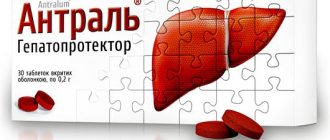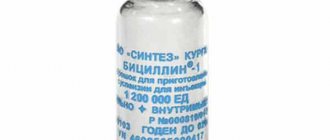Release form and composition
The drug is available in the form of tablets (250 mg each) in blister packs of 10 or 20 pieces. One cardboard box contains 1 package.
In addition, Amizon for children is produced in the form of tablets of 0.125 g, which are prescribed to children aged 6 to 12 years. There is also a drug for children in the form of syrup (Amizonchik), which is intended for children from 3 years of age for the treatment of ARVI and influenza.
The active ingredient in the drug is methylbenzylcarbamidopyridinium iodide.
Amizon price, where to buy
Amizon price in Ukraine (Kyiv, Kharkov, etc.) – from 25 UAH. for 10 tablets The price of Amizon Max is on average 60 hryvnia for 10 capsules. Children's Amizon can be purchased at a price of 20 hryvnia for 10 pieces.
- Online pharmacies in UkraineUkraine
- Online pharmacies in KazakhstanKazakhstan
Pharmacy24
- Amizon Max 0.5 g No. 10 capsules PAT "Farmak", Ukraine
67 UAH. order - Amizon 0.125 g No. 10 tablets PAT "Farmak", Ukraine
32 UAH order
- Amizonchik 10 mg/ml 100 ml syrup for children
70 UAH order
- Amizon 0.25 g No. 10 tablets PAT "Farmak", Ukraine
39 UAH order
- Amizon 0.25 g No. 20 tablets PAT "Farmak", Ukraine
68 UAH order
PaniPharmacy
- Amizon tablets Amizon tablets 0.25g No. 20 Ukraine, Farmak OJSC
74 UAH order
- Amizon tablets Amizon children's tablets 0.125g No. 10 Ukraine, Farmak OJSC
38 UAH order
- Amizon tablets Amizon tablets 0.25g No. 10 Ukraine, Farmak OJSC
48 UAH order
- Amizon max capsule Amizon Max capsules 0.5g No. 10 Ukraine, Farmak OJSC
85 UAH order
- Amizonchik liquid Amizonchik syrup 10 mg/ml bottle 100 ml (with dosed spoon) Ukraine, Farmak OJSC
78 UAH order
show more
Pharmacological properties
Pharmacodynamics
Amizon is an antiviral drug belonging to the group of isonicotinic acid derivatives. It effectively inhibits the activity of influenza viruses and other pathogens of acute respiratory infections due to a direct (inhibiting) effect on the process of penetration of viruses through cell membranes.
Methylbenzylcarbamidopyridinium (enisamium) iodide, the active component of Amizon, exhibits interferonogenic properties and leads to an increase in the content of endogenous interferon (α-interferon and γ-interferon) in the blood plasma by approximately 3-4 times. Amizon improves the body's resistance to viral infections, eliminates acute clinical symptoms of viral intoxication, and reduces the duration of the disease.
Pharmacokinetics
After oral administration, enisamium iodide quickly penetrates the bloodstream, and its maximum concentration in the blood is detected after 2-2.5 hours. The half-life is 13–14 hours. The active component of Amizon is metabolized in the liver, but is eliminated from tissues quite quickly (half-life is 2-3 hours). Enisamium iodide is excreted from the body through the kidneys in the form of metabolites in an amount of 90–95% of the dose taken.
Contraindications
- Hypersensitivity to iodine preparations and other components of the drug;
- the presence of allergic reactions, regardless of the nature of the allergen in the anamnesis;
- severe organic damage to the liver and kidneys;
- tuberculosis,
- Dühring's dermatitis herpetiformis (Dühring-Brock syndrome);
- manifest and latent hyperthyroidism;
- autonomous thyroid adenoma, focal and diffuse autonomous foci of the thyroid gland;
- hemorrhagic diathesis.
Indications for use
According to the instructions, Amizon is used for:
- Respiratory viral infections;
- Flu;
- Chicken pox;
- Rubella;
- Corey;
- Mumps;
- Chemoprophylaxis of hepatitis A and E;
- Cat scratch disease (fellinosis).
The drug is also effective as part of complex therapy for diseases and conditions such as:
- Bacterial, viral-bacterial, viral pneumonia and tonsillitis;
- Meningitis and meningoencephalitis of viral etiology;
- Cutaneous-articular form of erysipeloid;
- Hepatitis A and E;
- Herpetic infection;
- Pain syndromes with osteochondrosis, arthritis, herniated intervertebral discs.
Features of drug interactions
When taking Amizon, the effect of immunomodulatory, antibacterial, and antitoxic agents is significantly enhanced. From a therapeutic point of view, combining Amizon with high doses of vitamins, in particular ascorbic acid, is considered optimal and appropriate. Complex therapy, in which Amizon is combined with interferon, is justified. In this case, it is recommended that children be prescribed anti-influenza, as well as normal human leukocyte interferon, and adult patients - human recombinant genetically engineered interferon.
Instructions for use of Amizon: method and dosage
The drug should be taken orally after meals, without crushing or chewing. The maximum single dose should not exceed 1 g, and the daily dose should not exceed 2 g.
Typically, the course of treatment for adults, unless otherwise recommended, lasts 5-7 days according to the following scheme: 1-2 tablets (1 tablet corresponds to 0.25 g) 2 to 4 times a day.
For children aged 6 to 12 years, the same duration of treatment is provided as for adults, with a reduced dosage: 1/2 tablet 2-3 times a day.
Positive reviews about Amizon confirm its effectiveness for the prevention of influenza and ARVI. For prevention, adults should take 1 tablet daily for 3-5 days, then 1 tablet every 2-3 days for 2-3 weeks. For children 6-12 years old, the prophylactic dose is 1/2 tablet once every 2 days for 3 weeks. Children 12-16 years old should take 1 tablet every other day for 14-21 days.
The instructions for the drug indicate the following dosage regimens, each of which provides for taking the drug three times a day:
- For meningoencephalitis - 1 tablet for 10 days;
- For complex therapy of pneumonia - 1 tablet for 10-15 days;
- For complex therapy of viral hepatitis - 1 tablet during the first 5 days of illness;
- For pain syndromes - 1-2 tablets for 1-2 weeks.
The scheme for using Amizonchik syrup for children is as follows:
- Children 3-4 years old - 5 ml;
- Children 4-5 years old - 6 ml;
- Children 5-6 years old - 7 ml;
- Children 6-12 years old - 12 ml (if they cannot swallow Amizon for children in tablet form).
The syrup should be taken 3 times a day, preferably after meals, with a small amount of water.
After oral administration, the drug quickly enters the blood, where its maximum concentration is observed after 2-2.5 hours. The drug is metabolized in the liver and excreted from the body in the form of metabolites (95%) in the urine.
Analogs of Amizon in Russia
There are no analogues of amizon in terms of chemical composition, but there are medicinal formulas of drugs that are included in the pharmacological group of antiviral drugs that have a similar effect on the patient’s body and influenza viral particles.
A brief comparative overview of domestic medicines is given in the table.
Kagocel
from NEARMEDIC PLUS.
Kagocel triggers the production of interferon and stimulates the body's antiviral response if the virus enters the human body.
Analogue of amizon in terms of therapeutic effects.
Can be used by children from 6 years of age.
Amiksin
from PHARMSTANDARD.
Amiksin effectively acts against viruses, promotes the production of all types of interferons by the body itself, enhances the formation of antibodies, and has an inhibitory effect on viral variants.
Amiksin is better suited for the treatment of herpes, hepatitis or cytomegalovirus, although its use is justified for influenza.
They begin to use it in pediatrics at the age of seven.
Lavomax
from Nizhpharm.
It has an immunomodulatory and antiviral effect, stimulates the production of new bone marrow stem cells.
It is used in the treatment of patients over 18 years of age.
Arbidol
Manufacturer: OTCPharm.
The effect of arbidol is antiviral and immunomodulatory, active against influenza A and B, ARVI. Reduces the likelihood of complications during influenza conditions.
Ingavirin
from Valenta Pharmaceuticals.
Ingavirin suppresses the development and replication of viral particles, stimulates one’s own immunity, and has anti-inflammatory properties.
Grippferon
Firn M plant
Available in nasal drops and spray. It has a wide spectrum of action against influenza virus, adenovirus, para-, corono- and rhinoviruses.
Used for children from birth and pregnant women.
Tsitovir-3
from Cytomed.
Available in various dosage forms, which is convenient for use (capsules, syrup, solution for preparing a suspension).
Stimulates immune cells to develop a defense mechanism against various bacteria and viruses.
Yodantipyrine
Manufactured by Pharmstandard-Tomskkhimpharm.
Immunostimulant, has antiviral, anti-inflammatory properties, taken for immunodeficiency conditions. Thanks to this action, it is difficult for the virus to penetrate a healthy cell and produce new viral particles.
Read further: Antiviral drugs are inexpensive but effective for adults and children
special instructions
The analgesic activity of Amizon corresponds to that of amidopyrine and analgin, despite the fact that this drug begins to act later, pain relief with its use lasts longer.
The drug, unlike many analgesics, is low-toxic, does not have a negative effect on bone marrow hematopoiesis and the blood picture as a whole, and does not irritate the mucous membrane of the gastrointestinal tract.
The use of the drug as an antipyretic agent is significantly more effective than ibuprofen, butadione and salicylates.
The drug does not affect the ability to drive mechanical equipment and vehicles.
Which is better, ingavirin or amizon?
Ingavirin effectively fights the virus, has an active stimulating effect on the production of new structural interferons, strengthens immune cells, and suppresses possible inflammation that begins in the body.
Ingavirin is convenient to use; it is taken once a day.
There is, like Amizon, a children's form of the drug.
For the rest, you need to rely on the recommendations of a specialist who considers the picture of the disease as a whole, with an understanding of past diseases and individual contraindications for use.
Reviews about Amizon
Numerous reviews about Amizon are quite contradictory. Many patients consider it a very effective antiviral drug, but some users note the uselessness of the tablets and the lack of their positive effect on the body and the state of the immune system after a course of treatment. Moreover, most doctors claim that enisamium iodide has both therapeutic and preventive effects.
According to some reviews, the drug helps prevent influenza infection and acute respiratory viral infections during an epidemic. At the same time, there are references to the side effects of the drug, for example, the appearance of bitterness in the mouth.
Side effects
Amizonchik is well tolerated by patients, however, the possibility of developing such an undesirable effect of enisamium iodide cannot be excluded:
On the digestive system: bitter taste in the mouth, dryness of the oral mucosa, hypersalivation, yellow discoloration of the tongue, vomiting, swelling of the oral mucosa, pain in the epigastrium, a feeling of heaviness in the right hypochondrium. In addition, bloating and diarrhea may develop.
On the respiratory system: burning sensation in the throat, shortness of breath.
Allergic reactions: skin rash, urticaria, itching, Quincke's edema.
Other side effects: weakness, dizziness, blood pressure lability, headache.
Similar antiviral drugs
There are many analogues of this medicine. (Instructions for use for each should be studied individually, since despite the similar composition there are differences for children and adults!) But analogues can be found in large quantities in pharmacies across the country. They have the same mechanism of action, and they also belong to the same pharmacological group. These medications include the following:
• Amiksin; • Arbidol; • Remantodine; • Aflubin; • Novirin; • Imusstat; • Kagocel; • Lavomax; • Oksolin; • Panavir; • Tamiflu; • Anaferon; • Ergoferon.
The effectiveness of each of these medicines has been proven by experts, but in order to choose one medicine for yourself or your child, you need to consult a doctor and carefully read the package instructions and instructions for use. There is no need to take two drugs from the list provided, because they will simply duplicate each other's actions.
Which is better, amizon or arbidol?
Arbidol is prescribed only by a doctor, based on the general clinical picture and diseases suffered by the patient in the anamnesis.
It can be noted that arbidol has almost the same indications, but the list of contraindications is not as long as that of amizon. In addition, arbidol can be used in children from the age of two.





